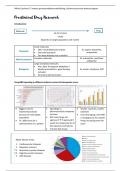Nikita Cassimon 2e master geneesmiddelenontwikkeling: biofarmaceutische wetenschappen
Preclinical Drug Research
Introduction:
Molecule Drug
Up to 12 years
Costly
Depends on target population and market
Small molecules
• SMI = Small Molecular Entities Ex. aspirin, fluoxetine,
Chemicals
• Oral administration omeprazole
• For many diseases not a solution
Complex molecules Ex. artemether, paclitaxel,
Natural products
vinblastine
Large (complex) molecules
• Also: New Therapeutic Modalities =
Biologicals biopharmaceuticals + gene therapy Ex. insulin, interferon, EPO
included
• Parenteral administration
Drug R&D spending in different industry sectors & therapeutic areas:
• Biggest cost for • Spendings in • Smaller countries, smaller
biopharmaceuticals pharmaceutical companies expenses
because of small target increase • Cost of bringing a new SMI
population • Not many drugs are or biological to the market
• Ex. 200k euros for 1 approved → if approved it keeps increasing over the
administration in 1 patient needs to compensate for al years
the expenses and failures
• ‘Fail fast Fail cheap’
Major disease areas:
1. Cardiovascular diseases
2. Neoplasm (cancer)
• 3. Respiratory system diseases
• 4. Digestive system diseases
5. CNS diseases
,Nikita Cassimon 2e master geneesmiddelenontwikkeling: biofarmaceutische wetenschappen
R&D spending & therapeutic areas:
• Biggest investment: clinical trials → facilities in the world and amount of patients
• Need for a nonclinical package depends on the patients
• Phase I CT: healty young males people → no women: potential fertilty danger + abortion →
recovery spermatogenesis after a few months
• Conclusion: risk in men is lower + smaller clinical package (less data needed)
Other factors:
Annual population growth Healthcare spending in relation Pharmaceutical sales by
rates: to age: region:
• Ideal: lot of target patients • Diseases/treatments • Most sales: USA → a lot of
• China: boost of pharma increase with ages OTC in supermarkets
companies → competition • You don’t want: adverse • Emerging: China
• Latin America: less effects → • Established ROW: India,
investment subtherapeutic dose Brazil
• Africa: increasing trend • = RISK/BENEFIT-ratio
Total cost for one new marketed drug = about 0.8 – 1.5 billion USD (depends on therapeutic area)
Orphan diseases = diseases occuring in a low amount of patients → definition depends on the place
and amount of patients (< 1000)
• Pharmaceutical companies don’t make profit with the development or drugs → you can make
profit if you’re ‘first-in-class’
• Investment by the Bill Gates foundation
• Some bigger companies tactically buy smaller companies to make profit
Compensate
investment by
making profit after
Decrease of profit
launching the drug
after expiring
patent + generic
competition
Investment in clinial
development → no
profit is made here
, Nikita Cassimon 2e master geneesmiddelenontwikkeling: biofarmaceutische wetenschappen
Blockbuster drug = a drug with sales > 1 billion USD/year
• Ex. Humira: 20 USD/year
• Blockbuster drugs moslty come from bigger companies, because they can afford a big investment
• Detectives visit smaller companies and detect drugs with potential,bigger companies later buy
them or steal the idea and license it
Top launches 2019: Patents: Competition in pharmaceutical
• Increase of • Patent will expire after 20 market:
biopharmaceuticals years, but 12 years are • Most profit fort he ‘first-in-
• Nonclinical package needed to develop drug → class’ developper
specialized for monoclonal profit for 8 years • Shrinking period of market
AB • SPC = supplementary exclusivity
• Gene therapy → protection certificate → • Inceased competition
companies decide what max. +5 years extra between pharmaceutical
refund the patient will get patented companies
Ex. Zolgensma • Me-too drugs = drugs die
op elkaar lijken
• Generics: high volume, high level of
competition, low value product, low medical
differentiation
• Mega-blockbusters: everything medium
• Targeted therapeutics: low volume, low level
of competition, high product value, high
medical differentiation
Failure rates in drug development:
‘Fail Fast Fail Cheap’
Phase I: No adverse
effects in young healthy
men
Approved: post-marketting
Phase II: Lack of efficacy issues → impact on image
on bigger scale of company
, Nikita Cassimon 2e master geneesmiddelenontwikkeling: biofarmaceutische wetenschappen
Biotechnology-derived medicines:
• Oligonucleotides working on mRNA
• Small interfering RNAs Larger proportion of
• Micro RNAs ‘first-in-class’
• Vaccines therapeutics
• Monoclonal antibodies
Ex. In 1982: Recombinant human insulin or Humulin®
Major pharmaceutical companies (from biggest to smallest):
• Locations: 150 countries • Locations: > 140 countries and > 100,000
• Headquarter: Basel, Switzerland employees
• Diagnostics • Headquarter: Basel, Switzerland
• Sandoz for generics
• Locations: > 150 countries • Locations: 120 countries
• Headquarter: New York, USA • Headquarter: Whitehouse Station, New
• Belgian sites: Puurs (no R&D but Jersey, USA
manufacturing)
• Offers a broadspectrum of drugs
• Drugs not approved for humans used for
animals
• Locations: > 55 countries • Locations: > 100 countries and > 100,000
• Headquarter: New Brunswick, New Jersey, employees
USA • Headquarter: Paris, France
• Beerse: R&D, pharmaceutical production • Ablynx is bought by Sanofi in 2018
(tablets, ointments, e.a.)
• Geel: chemical production (API)
• Olen: pharmaceutical production
• Locations: 117 countries • Locations: mainly Japan, but also
• Headquarter: UK Switzerland, USA, UK and Singapore
• OTC and toothpaste focused • Headquarter: Osaka, Japan




